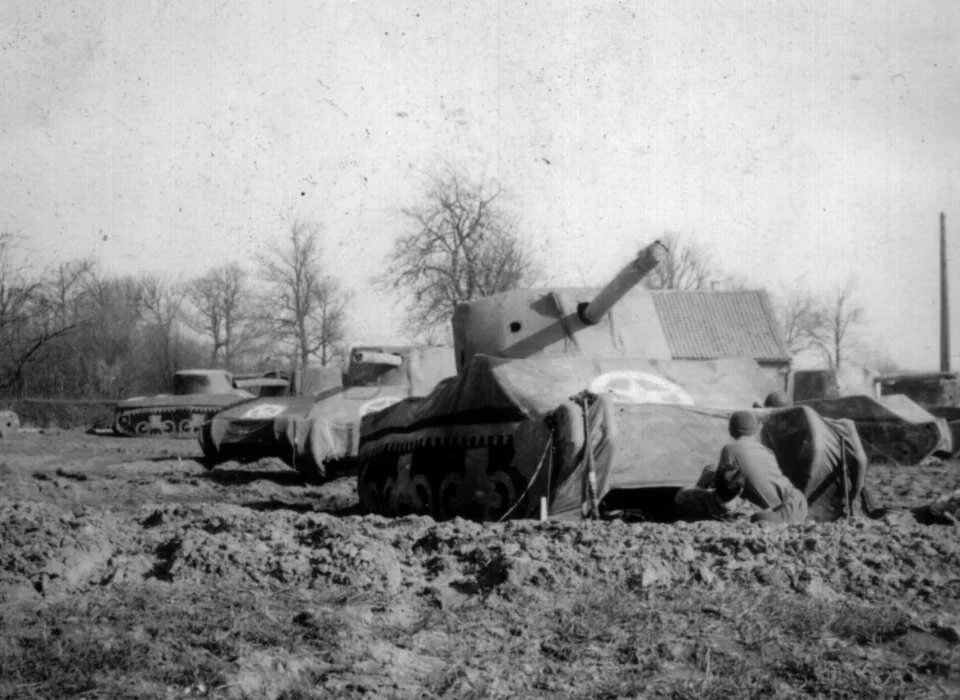Last month, Gilbert Seltzer, passed away at his home in West Orange, NJ. He was 106.
Mr. Seltzer worked as an architect until January 2020.
His age and long work life are certainly impressive.
But Mr. Seltzer spent 1-year of his 75-year career doing something historical that has been retold in books and documentaries.
He was part of a secret Army unit in World War II known as the Ghost Army.
Mr. Seltzer was one of 1,100 soldiers attached to the 23rd Headquarters Special Troops.
These soldiers designed and built inflatable tanks, cannons, planes and trucks, and devised realistic-sounding radio messages to mimic troop movement. They used these fake “sights and sounds” to throw off German forces so American troops could move in undetected
Image Source: http://www.psywarrior.com/DeceptionH.html
During a StoryCorps interview in 2019, Mr. Seltzer said, “We would move into the woods in the middle of the night, going through France, Belgium and Germany, and turn on the sound” — from blaring loudspeakers — so it sounded like tanks were moving on the roads. The natives would say to each other, ‘Did you see the tanks moving through town last night?’ He added, “They thought they were seeing them. Imagination is unbelievable.”
They were civilian artists turned military con artists.
Members of this special unit are credited with playing a critical role in the Rhine River Campaign, which brought the war to its end. And with saving upwards of 30,000 lives.
The Ghost Army was the brainchild of Colonel Billy Harris and Major Ralph Ingersoll, American military planners based in London. It consisted of carefully selected artists, illustrators, designers, and engineers, as well as, professional soldiers, and draftees.
Famed members included fashion designer Bill Blass, painter Ellsworth Kelly, and photographer, Art Kane.
We are especially inspired by the leadership lesson of diversity that the Ghost Army provides us.
Acquired Diversity is a Force Multiplier
Did you know that there are different kinds of diversity?
The word diversity typically refers to traits of age, gender, race, ethnicity, and sexual orientation. These are considered inherent diversity – traits you were born with.
But, what about our education, industry background, or working in a foreign country? These can provide us with unique skills that can add tremendous value (and diversity!) to teams and organizations.
This is called acquired diversity – traits you gain from your experiences.
Have one, or the other, is fine.
Having both is a secret superpower. A force multiplier.
Harvard Business Review calls this “2-D diversity.”
It creates a space where “out of the box” thinking is encouraged, and “crazy ideas” are heard.
Teams and organizations with inherent AND acquired diversity benefit from greater critical thinking, innovation, and creativity.
You can accomplish great things, overcome big challenges, and create innovative solutions.
2-D diversity also massively improves your bottom line.
Research has shown that employees at organizations with 2-D diversity are 45% more likely to report growth in market share over the previous year.
On the flipside, those who lack 2-D diversity report that women are 20% less likely than white men to have their ideas supported. People of color are 24% less likely and LGBTQ people are 21% less likely.
In How Diversity Can Drive Innovation, HBR authors point out that losing these ideas costs companies critical market opportunities, “because inherently diverse contributors understand the unmet needs in under-leveraged markets.”
Artists and designers are probably not the first people you would pick to fight a world war.
However, we can’t argue that it was their 2-D diversity that created a branch of the military that otherwise may have not existed.
And, in turn, played a key role in winning a world war.
Take a good look around at your team. You might have a Ghost Army in your midst.
Leverage Individual Strengths for Organizational Wins
Clearly, these artists and creator’s individual strengths were leveraged to accomplish the greatest organizational win.
Rather than be put on a tank or handed a gun, the Ghost Army’s commanders carefully assigned the most appropriate responsibilities to each individual soldier.
As leaders we are responsible to the organizations mission and vision, and to the individuals we lead. The people who, in turn, carry out the mission and vision.
It is our job to leverage individual strengths to accomplish organizational wins.
Just as those artists strengths were leveraged to win the war.
When we tap into someone’s strengths we will be repaid with an excited, committed, and motivated employee.
An employee who feels their strengths are being ignored or wasted will become disinterested and demotivated.
Focusing on 2-D diversity can help invigorate a disinterested employee or re-motivate a sluggish team.
Great shifts are happening in the world of work. You may be feeling this shift in your organization or even within your small team.
Executives are retiring, managers are moving up, employees are leaving to find new opportunities.
Now is a good time to focus on your organization’s 2-D diversity. To leverage individual skills for the greatest organizational wins.
Ask yourself:
Do I know each of my team members acquired skills?
How can I learn more about them? Is it a conversation or a survey? Something else?
How can I best leverage these skills and talents during this time of great change?
What skills will our organization need in the next 5, 10, 15+ years? How can we attract people with those diverse skills?
Sir Tim Berners-Lee, the inventor of the world wide web once said,
“We need diversity of thought in the world to face the new challenges.”
As we continue to navigate unfamiliar territory and so much is unknown it will, and must be, our diversity that shows us the way.


